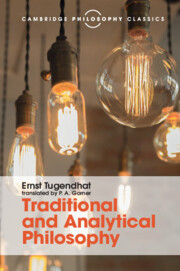Book contents
- Frontmatter
- Dedication
- Contents
- Preface
- Preface
- Translator's preface
- Part I Introduction: confrontation of analytical philosophy with traditional conceptions of philosophy
- Part II A first step: analysis of the predicative sentence
- 8 Preliminary reflections on method and preview of the course of the investigation
- 9 Husserl's theory of meaning
- 10 Collapse of the traditional theory of meaning
- 11 Predicates: the first step in the development of an analytical conception of the meaning of sentences. The dispute between nominalists and conceptualists
- 12 The basic principle of analytical philosophy. The dispute continued. Predicates and quasi-predicates
- 13 The meaning of an expression and the circumstances of its use. Dispute with a behaviouristic conception
- 14 The employment-rule of an assertoric sentence. Argument with Grice and Searle
- 15 Positive account of the employment-rule of assertoric sentences in terms of the truth-relation
- 16 Supplements
- 17 ‘And’ and ‘or’
- 18 General sentences. Resumption of the problem of predicates
- 19 The mode of employment of predicates. Transition to singular terms
- 20 What is it for a sign to stand for an object? The traditional account
- 21 The function of singular terms
- 22 Russell and Strawson
- 23 What is ‘identification’?
- 24 Specification and identification. Specification and truth
- 25 Spatio-temporal identification and the constitution of the object-relation
- 26 Supplements
- 27 Results
- 28 The next steps
- Bibliography
- Index of names
- Index of subjects
25 - Spatio-temporal identification and the constitution of the object-relation
from Part II - A first step: analysis of the predicative sentence
Published online by Cambridge University Press: 05 August 2016
- Frontmatter
- Dedication
- Contents
- Preface
- Preface
- Translator's preface
- Part I Introduction: confrontation of analytical philosophy with traditional conceptions of philosophy
- Part II A first step: analysis of the predicative sentence
- 8 Preliminary reflections on method and preview of the course of the investigation
- 9 Husserl's theory of meaning
- 10 Collapse of the traditional theory of meaning
- 11 Predicates: the first step in the development of an analytical conception of the meaning of sentences. The dispute between nominalists and conceptualists
- 12 The basic principle of analytical philosophy. The dispute continued. Predicates and quasi-predicates
- 13 The meaning of an expression and the circumstances of its use. Dispute with a behaviouristic conception
- 14 The employment-rule of an assertoric sentence. Argument with Grice and Searle
- 15 Positive account of the employment-rule of assertoric sentences in terms of the truth-relation
- 16 Supplements
- 17 ‘And’ and ‘or’
- 18 General sentences. Resumption of the problem of predicates
- 19 The mode of employment of predicates. Transition to singular terms
- 20 What is it for a sign to stand for an object? The traditional account
- 21 The function of singular terms
- 22 Russell and Strawson
- 23 What is ‘identification’?
- 24 Specification and identification. Specification and truth
- 25 Spatio-temporal identification and the constitution of the object-relation
- 26 Supplements
- 27 Results
- 28 The next steps
- Bibliography
- Index of names
- Index of subjects
Summary
What we achieved in the last lecture was a preliminary clarification of the concept of identification which sufficed to explain the division into levels in the specification-question and to confirm the sharp distinction between locating and non-locating descriptions. We can now disregard non-locating descriptions and confine ourselves to the problem of identification, since it has become apparent that the question of what is meant by ‘perceptual objects’ and how we are able to refer to such objects centres on this problem.
To this end we must again take up the question of how singular terms are used and how one establishes for which object they stand. Whereas in the previous lecture we were concerned to distinguish the use of demonstrative and locating singular terms from non-locating singular terms, our concern will now be to explain, from the same methodological perspective, the interdependence of demonstrative singular terms and objectively locating singular terms as regards their function in the identification of perceptible objects. We shall have to so approach this problem that we simultaneously aim at a clarification of the difficulty we encountered at the end of the last lecture when the hypothesis arose that perhaps spatial and temporal positions rather than objects that are in space and at times are to be regarded as the most elementary objects. We must therefore put the question about spatio-temporal identification in such a way that initially we leave open the question of whether the identification of spatial (extended) objects and temporal objects (events) depends on the identification of places and times or whether the reverse is true or whether there is an interdependence between them.
Of course, one can only speak of places and times as objects if there are corresponding singular terms. But clearly there are such terms. In particular the demonstratives ‘here’ and ‘now’ are such. Despite their syntactic difference from the other singular terms they fulfil all the semantic conditions for singular terms with which we have become acquainted. By means of the words ‘here’ and ‘now’, if they are used in a specific situation, something is specified and even identified. An individual spatio-temporal position is singled out from all spatio-temporal positions as that which can be classified by a predicate (for example if we say ‘Here and now it is hot’).
- Type
- Chapter
- Information
- Traditional and Analytical PhilosophyLectures on the Philosophy of Language, pp. 349 - 359Publisher: Cambridge University PressPrint publication year: 2016



